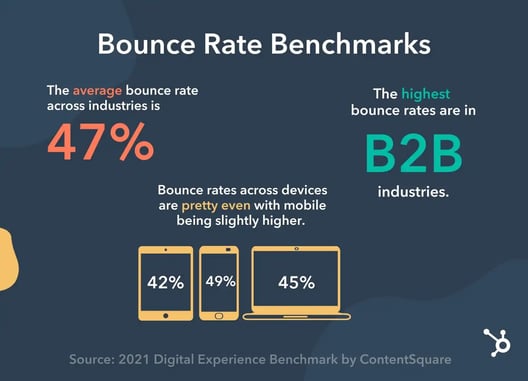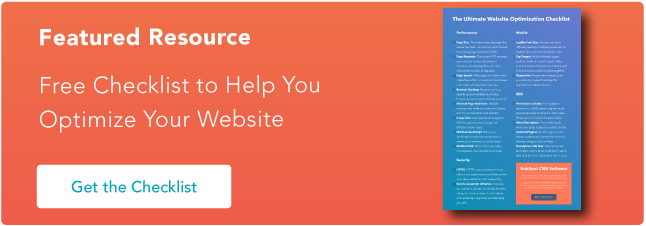Your website's bounce rate is a metric that indicates the percentage of people who land on one of your web pages and then leave without clicking anywhere else on your website – in other words, single-page visitors.
How sticky is your website? If visitors bounce, it suggests they either didn't find what they were looking for, or the page wasn't user-friendly. A high bounce rate also means visitors aren’t looking for more content on your site, clicking on your calls-to-action, or converting into contacts.
For inbound marketers whose primary goal is to attract and convert website visitors into highly qualified leads for their sales teams, it’s scary stuff. So, let’s get into how to decrease your bounce rates.
Improving Your Bounce Rate Infographic
Fortunately, QuickSprout has created an awesome infographic that explains why bounce rate is so important, highlights benchmark industry averages for bounce rate, and identifies a variety of changes you can make to help reduce your website’s bounce rate. Check it out!
And if you want help converting visitors who are about to bounce from your site, try using HubSpot's free lead capture tool Lead Flows to create a call-to-action with a relevant offer triggered by exit intent.

Bounce Rate Benchmarks
Having a benchmark is so valuable when trying to understand where you stand against competitors in your industry.
Find below some 2021 key statistics on bounce rates.

How to Decrease The Bounce Rate On Your Site
- Set realistic expectations.
- Attract the right visitors.
- Prioritize the user experience.
- Speed up your page load time.
- Produce high-quality content.
- Monitor, test, and optimize.
1. Set realistic expectations.
When it comes to your bounce rate, it’s important to set the right expectations. As mentioned in the infographic, look at your historical data as a baseline for how your website has performed in the past.
Then, compare it to the average for your industry and platform.
Let’s say your company is a B2B brand with an average bounce rate of 56%. As seen in the previous section, the average bounce rate across industries is 47%, so you might say yours is really high.
However, the data also shows that bounce rates are much higher for B2B industries, at 75%. So, at 56%, your company is actually doing quite well. While this doesn’t mean you should stop your efforts at reducing the bounce rate, it’s important to know how you stack up against benchmarks.
In this case, where you’re only in competition with yourself, it’s time to rely on historical data to guide your strategy.
2. Attract the right visitors.
Picture yourself in a grocery store. You’re looking for a particular item and you go down an aisle. You look around and you can’t find it. So, what do you do? Leave the aisle and ask for help, or just try the next one.
Think of your website as an aisle at the store. If your content doesn’t match the visitors you’re attracting, they’ll quickly leave.
So, how do you make sure you’re attracting the right visitors?
- Create multiple landing pages with unique content and keywords for your different buyer personas.
- Maintain top rankings for branded terms.
- Write attractive, useful meta descriptions for search engine users.
- Improve targeting of online advertising campaigns.
3. Prioritize the user experience.
In this day and age, no one has the patience to navigate through a difficult website. You only have a few seconds to make a good impression and present a website that users enjoy being on.
To do so, follow these steps:
- Make your text readable through sensible organization and the use of larger fonts, bulleted lists, white space, good color contrast, and large headlines.
- Use well-organized, responsive layouts that allow for quick and easy navigation on all platforms and browsers.
- Don’t let ads distract from your content: Place static ads to sides, and avoid pop-ups and self-loading multimedia ads.
4. Speed up your page load time.
Page speed is one of the main reasons website visitors leave a website. In fact, Google reported in 2017 that when a page load time goes up to 10 seconds, the bounce rate on mobile goes up 123%.
Think about it: When was the last time you waited over a minute for a page to load? Most users’ first instinct is to exit and find another website to meet their needs.
Several factors can contribute to a slow website:
- Image size
- Self-loading multimedia content.
- Site server
The ideal page load time is two seconds or less. Make sure you test your page speed regularly to ensure it falls within that timeframe.
5. Produce high-quality content.
Content can make or break your website visitor’s experience.
Your content should be:
- Engaging – Does your content make your visitors want to keep reading?
- Clear – Is your content easy to understand and digest?
- Relevant – Does it answer the question your website visitors are asking? Or is it clickbait (a big no-no)?
If you’re not sure how to answer these questions, have an objective third-party review your content. You should also consider hiring a copywriter who is an expert at producing high-quality content.
6. Monitor, test, and optimize.
Every change you make to your website can have an impact on your bounce rate. From the placement of an ad to the content on the page.
With this in mind, you must monitor your website closely to assess traffic changes. If you notice a rise in your bounce rate and a drop in visitors, run A/B tests to determine what page elements could be affecting your traffic.
Once you identify the issue(s), optimize your page.
When it comes to bounce rate, there’s always room for improvement. Use optimization tools (more on that in the next section) to identify opportunities to lower your bounce.
Want to start optimizing? Use this checklist to maximize your website’s performance.
How to Decrease your Bounce Rate on Shopify
When you run an ecommerce business, monitoring your bounce rate is a priority, as an increase can drastically impact revenue.
To first thing you can do to decrease your bounce rate on your Shopify website is to make sure your search campaign is aligned with your landing page. This means ensuring the keywords you’re targeting align with what you’re offering on your landing page.
In addition, your landing page should be optimized for conversion by following best practices (e.g. clear CTA, no navigation bar).
The next step is to add credibility to your page. You can do so by displaying customer reviews and testimonials as social proof. You can also add trust badges on your website to indicate you’re a reputable company.
To further improve your page’s performance, add a live chat feature to assist website visitors as they shop. You may learn valuable insights from these interactions that help you optimize your page.
Lastly, invest in tools like Optimizely, Hotjar, Unbounce, and Crazy Egg to better understand your visitors’ behavior on your site and identify areas for improvement.
How to Decrease Bounce Rate of Your Blog
Reducing your blog’s bounce rate is all about following tried-and-true formulas:
- Have a clear structure and page hierarchy – Using headers and subheaders help visitors (and search engines) understand what information is on the page and how it is organized.
- Use high-quality media – Photos, gifs, illustrations, and videos are great for breaking up long sections of text as well as diversifying your information delivery method.
- Make your content error-free – When users see a page riddled with mistakes, it can make them question the brand’s credibility and lead them to exit out of the page.
- Include a clear call-to-action – Having a clear next step for your website visitor will help guide them in the direction you want them to go. Want them to read other articles? Hyperlink them in your post. Want them to download an offer? Include the CTA in the post.
How to Decrease Email Bounce Rates
Email bounce rates are defined differently than bounce rates on other channels.
An email bounce rate refers to the number of emails that are not delivered to a subscriber list. There are two types of bounce rates: hard and soft. The former refers to a permanent reason why the email cannot deliver while the latter refers to a temporary issue.
For instance, say you have 100 email subscribers. You send an email blast and 98% of them receive your email. Your email bounce rate, in this case, would be 2%.
The average bounce rate is 0.7%, according to Campaign Monitor. However, this number can vary slightly by provider.
A bounce rate ranging between 0 and 2% is normal. Anything beyond that and you’ll want to look deeper.
Here are some ways to reduce your email bounce rate:
- Use double opt-ins – Sending a confirmation email to a recipient with a CTA to subscribe will ensure the submitted email is correct and working properly.
- Clean out your subscriber list regularly – Removing inactive subscribers is another way to verify that your email addresses on file work are healthy and active.
- Invest in a reputable email provider– Free sender platforms will not cut it when it comes to email marketing. This means leaving your Gmail, Hotmail, or Yahoo accounts for personal use and looking into HubSpot, MailChimp, SendinBlue, and more.
Designing a Website with a Low Bounce Rate
Having a website with a bounce rate requires constant monitoring and maintenance.
By making sure your content is aligned with your visitors’ needs, your content is easy to navigate, and your conversion elements are clear, you can keep a low bounce rate.
Ready to start optimizing your website? Use this checklist as your guide. It includes everything you’ll need to improve your website performance, including SEO and security.
Editor's Note: This post was originally published in July 2014 and has been updated for comprehensiveness.
Web Analytics


![Free Resource: Website Optimization Checklist [Download Now]](https://no-cache.hubspot.com/cta/default/53/00d9cc96-eff7-4cea-8ff3-583374c3dcd5.png)



![How Many Visitors Should Your Website Get? [Data from 400+ Web Traffic Analysts]](https://www.hubspot.com/hubfs/how-much-traffic-does-website-get.png)


![What Is the Average Time Spent On a Website? [+ How to Improve It]](https://www.hubspot.com/hubfs/GettyImages-1356122303%20copy.jpg)